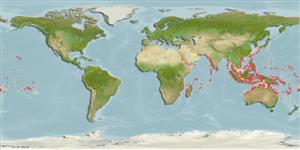Common names from other countries
Environment: milieu / climate zone / depth range / distribution range
Sinh thái học
; Mức độ sâu 0 - 30 m (Ref. 349). Tropical; 35°N - 34°S, 30°E - 138°W
Indo-Pacific.
Length at first maturity / Bộ gần gũi / Khối lượng (Trọng lượng) / Age
Maturity: Lm ? range ? - ? cm Max length : 16.0 cm SHL con đực/không giới tính; (Ref. 349); common length : 9.0 cm SHL con đực/không giới tính; (Ref. 349)
Commonly collected for food in many parts of the area, mainly in the shallow water zone. Shell used for shellcraft. Due to frequent over collecting and destruction of the coral reef environment by dynamite fishers, this species may be nearly extinct locally or confined to the deeper part of its habitat (to depths over 10 m) (Ref. 349). Known to be abundant in reef areas, on sand, among rocks (Ref. 128042), on branched corals, often nearby seaweeds. Active during the day (Ref. 349). Omnivore (Ref. 112158). In general, cowries are observed to feed on sponges, live gastropods, seaweed, and carrion (Ref. 112163).
Life cycle and mating behavior
Chín muồi sinh dục | Sự tái sinh sản | Đẻ trứng | Các trứng | Sự sinh sản | Ấu trùng
Members of the order Neotaenioglossa are mostly gonochoric and broadcast spawners. Life cycle: Embryos develop into planktonic trocophore larvae and later into juvenile veligers before becoming fully grown adults.
Poutiers, J.M. 1998. (Ref. 349)
IUCN Red List Status (Ref. 130435)
CITES status (Ref. 108899)
Not Evaluated
Not Evaluated
Threat to humans
Harmless
Human uses
Các nghề cá: Tính thương mại
| FishSource | Biển chung quanh ta
Các công cụ
Thêm thông tin
Age/SizeSự sinh trưởngLength-weightLength-lengthHình thái họcẤu trùngSự phong phú
Các nguồn internet
Estimates based on models
Preferred temperature
(Ref.
115969): 25.4 - 29.3, mean 28.7 (based on 2229 cells).
Vulnerability
Low vulnerability (10 of 100).
Price category
Unknown.
